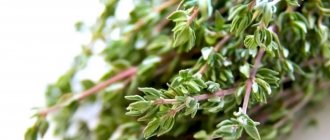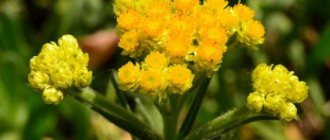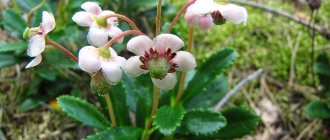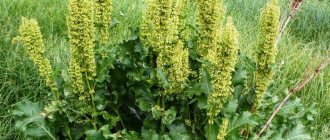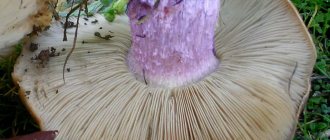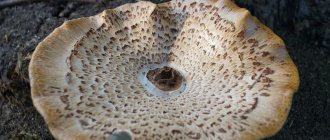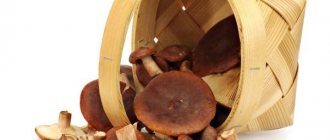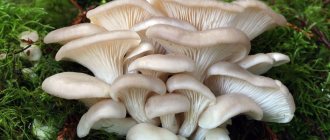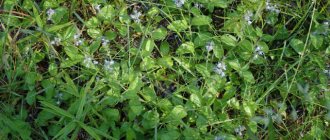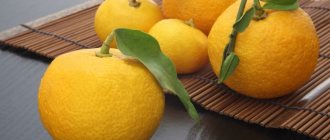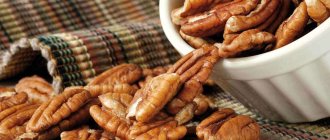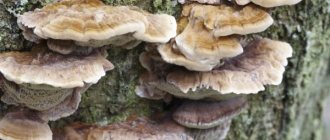Important facts about valueu mushrooms. Let's find out why this mushroom is not very valued by mushroom pickers and why you need to put it in your basket. Let's find out what other popular names this mushroom has, consider the characteristics of growth and appearance, as well as false doubles and how it can be prepared for the winter.
Valui mushrooms and everything you need to know
Description and useful properties
First of all, it should be noted that the value of the mushroom contains an impressive amount of protein, which functions as the main building element in the body.
So, 100 gr. The product contains twice as much protein as in eggs or meat. Valuei mushrooms can be classified as low-calorie dietary products (only 29 kcal per 100 g of product).
It should also be noted that despite the low calorie content, valui is very nutritious, and the feeling of fullness persists for a long time.
90% of the composition of value is water. If you subject them to heat treatment, it will completely leave the mushrooms, leaving only valuable microelements.
In addition to proteins, these are valuable amino acids such as arginine, tyrosine, leucine. Hence the benefits of eating these mushrooms:
- contribute to the normal functioning of the cardiovascular system;
- improve digestion, helping to digest food;
- contribute to the rapid removal of harmful cholesterol from the body;
- promote weight loss, because they contain a small proportion of fats and carbohydrates, practically the same as vegetables;
- have a beneficial effect on the functioning of the immune system;
- are a strong antioxidant that can prevent the development of cancer (small content of the substance ergothioneine).
The mushroom contains many vitamins (retinol or vitamin A, C, B1, B2, B5, B6, B9, PP or niacin) and minerals (potassium, calcium, magnesium, sodium, phosphorus, chlorine, iron, iodine, cobalt, molybdenum , fluorine, chromium, zinc).
The chemical composition proves that these mushrooms are beneficial. But, you need to remember that valui are conditionally edible mushrooms. Therefore, they should not be the main course.
Valui are characterized by low nutritional value. Water makes up a huge part of the product. During heat treatment, water completely disappears from the product, leaving only the substances needed by the body. The main part of them are proteins and amino acids. These components help food digest and rid the body of bad cholesterol.
hat
The mushroom cap has a spherical configuration of various sizes, has a convex shape with curved edges that go around the stem. In older valuuya this part is straighter than in younger specimens. The color of the cap is yellowish-brown. Valui have plates that, depending on age, change color from white to a darker brown tone; they belong to the genus Russula.
Material on the topic: What does the blue leg mushroom look like, where does it grow and when to collect
Leg
In young plants, the stem is barrel-shaped, thickest in the middle part. Over time, it stretches into a cylinder up to 12 cm high and 3 cm in diameter. At first it is fleshy inside, then it becomes loose and can break easily. Color ranges from white to greyish.
Description of the mushroom valui.
Records
Plates of different lengths are located on the underside of the cap. Their color ranges from white to creamy-grayish. The plates have some peculiarity. They secrete a clear liquid that dries in a short period of time and becomes brown in color.
Spore-bearing layer
The spore powder is always cream-colored, and the spores are small and warty in shape. The plates can be of varying lengths, narrow and dense, painted white or creamy-grayish. The main feature is that the plates secrete a liquid - transparent, yellowish in color, which dries quickly and acquires a brown tint.
Pulp
The pulp of the mushroom is brittle, its smell resembles sour milk, and it tastes bitter. At the cut site it quickly oxidizes and acquires a brownish tint.
Valuy.
Appearance of fruiting bodies and habitat
Valui mushrooms are classified as russula. Many people think that they are not edible and are not collected in season, but valui is a conditionally edible mushroom. People gave it the names “bull”, “snotty” and “fist”. It looks like a russula in appearance.
Irina Selyutina (Biologist):
Species features of the value mushroom:
- The cap of young mushrooms is spherical.
- The skin from the surface of the cap is easily removed.
- The hymenophore plates are adherent, forked, of different lengths, secrete a yellowish transparent liquid, which, when dried, leaves brown spots.
- Valuya spores are amyloid, i.e. stained under the influence of iodine.
- The pulp has a pungent bitter taste, its unpleasant odor is similar to the smell of rancid oil.
- With age, an irregularly shaped cavity forms in the middle of the leg.
Appearance of mushrooms of the valui species:
- The curved or straightened cap, up to 15 cm in diameter, has a ribbed edge. There is mucus on it, which dries out in the heat. The skin is ocher-yellow or ocher-brown.
- In young individuals the plates are white-cream, in adults they are yellow. When damaged, juice is released.
- The pulp darkens with age and in humid weather has an unpleasant damp smell and a burning taste. May cause nausea.
- According to the species description, the stem of a young valu mushroom is dense and barrel-shaped. In adult specimens it is hollow and filled with soft tissue, growing up to 12 cm in height. Shades vary from cream to brown-yellow.
By July, whole placers of valuev ripen in the forests, and remain there until the end of October. They are not picky about the soil and its cover, so they grow in any forest, but prefer moist soil. Valui mushrooms are often located in scattered areas in the shade of both deciduous and coniferous trees, although many mushroom pickers believe that the species should be looked for only in deciduous forests.
Valui is a mycorrhiza-former that enters into a symbiotic relationship with representatives of coniferous and deciduous tree species; it can often be found in birch forests or in forests with an admixture of birches.
The habitat is located in the European part of Russia, western Siberia, the Far East and the Caucasus.
You can also find the Crimean species. According to Western European opinion, this species is inedible, but in Slavic territories it has long been consumed in salted form and prepared as caviar.
Valui mushrooms are classified as russula
In order not to endanger your life, you need to know how edible fruiting bodies differ from false ones. Hebeloma is considered the most dangerous for humans - a poisonous mushroom that disguises itself as russula or porcini.
When and where to collect valui
After studying the detailed description with photos and learning how to prepare the mushroom, you can safely go in search of it. But preferably 2-3 days after heavy rains, since valui loves places where it is humid. But it does not tolerate heat, and on hot days it completely stops bearing fruit, so you should look for it in shady places in deciduous, mixed forests and birch forests.
You can collect the mushroom as early as July and until October. As a rule, it grows in small colonies, from 5 to 10 pieces, although single specimens can also be found.
For reference! Distribution area: Middle zone, Western Siberia, Far East and Caucasus.
Valui mushrooms (gobies, kulaks, kulbiki, snotty mushrooms): photo and description
| Name: | Valuy |
| Latin name: | Russula foetens |
| Type: | Conditionally edible |
| Synonyms: | Goby, Pig, Kulbik, Snotty, Fist |
| Characteristics: |
|
| Taxonomy: |
|
The value mushroom is not the most common and favorite among Russian mushroom pickers. However, if processed correctly, it will not only delight you with a pleasant taste, but will also be very valuable for your health.
Doubles of Valueu
The mushroom has no poisonous counterparts. There is a false valu, which has a sharp and unpleasant odor, reminiscent of horseradish. It grows from late summer to early September. People called it the “horseradish mushroom.” It is very similar to its edible counterpart, but has a number of characteristic differences:
- There is a small bump in the center of the cap.
- The leg thickens at the base and is covered with small scales.
- The cap and leg have a brown or dark yellow tint.
The false valua lacks the ring characteristic of poisonous species. However, eating this mushroom leads to serious poisoning.
Beginning mushroom pickers may confuse valui with some specimens of almond russula and Morse russula. The first mushroom has a characteristic odor of almonds, and the second has yellow plates with a noticeable purple tint around the edges. In order not to confuse the valui with a porcini mushroom, just look under the cap; the goby has plates there, and the boletus has tubes.
It is better not to take overripe mushrooms and not to cut off dubious specimens, so as not to put that same worthless mushroom in the basket.
Amanita straw yellow
The diameter of the bright yellow fly agaric cap ranges from 5 to 12 centimeters. At first its shape is hemispherical, and as it grows it becomes flat-spread. When dry, the surface of the cap is silky-shiny, and in wet weather it becomes sticky. The cap is naked with grayish flakes and small grayish warts. Warts and flakes are easily washed off by rain. The edge of the cap is striped.
The color of the bright yellow fly agaric cap is quite varied. As a rule, the color is ocher-yellow or beige-yellow, but it can be almost white, golden and orange. The plates are often located, wide, soft, white, and with age they can become creamy or yellowish. The flesh under the skin is yellowish, but beyond that it is white. The pulp has a faint mushroom or rare aroma. The taste is inexpressive or slightly sweet.
Amanita straw-yellow.
The height of the leg is 4-15 centimeters, and the diameter is 0.5-1.5 centimeters. The leg is slender, with a slight thickening noticeable at the bottom. With age, the leg becomes hollow. Its structure is quite fragile. On the stem there is a membranous ring, white or yellowish in color. Above the ring, the surface of the stalk is smooth, but below it is slightly pubescent or scaly. The ring quickly disappears, and a fuzzy mark remains on the leg. The color of the legs is white or yellowish. The volva is soft, short, poorly noticeable, and grows at the base of the leg.
These fungi form mycorrhiza with hornbeam, linden, oak, beech and hazel. They grow in forests, including mountain ones. They grow in the southern temperate zone of the European part and Eastern Siberia. Bright yellow fly agarics bear fruit from June to October.
Gebeloma adhesive (false valui)
The fruiting bodies are light, with a hemispherical cap, which later becomes flat. The skin is creamy white, sometimes light brown, covered with mucus, then smooth and fibrous. The leg is smooth, up to 8 cm high, hollow, the surface is mealy or covered with scales. The plates are creamy-yellowish, with a brown tint in older specimens. The pulp is fleshy, creamy or brownish, very bitter with a characteristic strong odor reminiscent of radish or horseradish. It is the pungent odor, as well as the scales on the stalk, that are the distinctive features of this poisonous mushroom.
Hebeloma is sticky.
Gebeloma adhesive grows in meadows, forest clearings under trees of various species, often in large families, forming peculiar rings. You can see these mushrooms from late summer until severe frosts, and sometimes during thaws. A very poisonous species causes digestive disorders - nausea, vomiting, gas formation, painful colic; nervous phenomena - headaches, weakness, tingling in the fingers. In case of hebeloma poisoning, immediate medical attention is required.
Additional material: Where to collect oyster mushrooms and how to grow them at home
Russula almond
Almond russula can be found in deciduous or mixed forests, very rarely in coniferous forests. The most favorable conditions for its growth are in oak and beech plantings. This representative of the Syroezhkov grows solitarily; small groups are occasionally found. The fruiting period is quite long - mushrooms can be collected throughout the summer and autumn. The cap of the almond russula gradually changes as the mushroom grows: at first it is raised, bell-shaped, then it becomes almost flat, and by the end of ripening it is concave, with a pronounced depression in the center.
The color also depends on age: from sandy yellow in young specimens to rich brown in older specimens. The shape of the cap is round; for mature mushrooms, the edges are ribbed. Its average diameter is 5 - 8 cm. The pulp is white, very fragile, and does not change color at the cut site. The lower edge of the cap consists of plates of different lengths, partially fused with the stem. Their color can be milky, beige or cream, and in old mushrooms it can be reddish. The spore powder is usually white, and the spores themselves are round and colorless.
Russula almond.
The leg of this species has a regular cylindrical shape. It is smooth to the touch, but inside it is porous and easily broken. The color changes from brownish - in its lower part to white - closer to the cap. The height of the leg is 7 - 10 cm.
Growing at home and in the country
Cowsheds can be quite successfully cultivated on a personal plot. This is a fairly unpretentious plant that can grow near any trees. To begin with, you should purchase mushroom mycelium in a specialized store (its price is about 180 rubles). Further actions should be carried out in this order:
- Dig up and fluff up the soil near the tree. Dig a hole 5–15 cm.
- Scatter the mycelium over the entire surface of the soil.
- Mix the soil with humus in equal parts. Sprinkle the planting area.
- Water at the rate of 10 l/1 m².
- Sprinkle with the soil that remains from digging.
- The first mushrooms will appear no earlier than 2.5 months after planting. Harvests can be harvested 4 times a year: twice in spring and 2 times in autumn. The mycelium grows as long as the tree exists.
Important! The first harvest is 350-500g/m2, subsequent ones - 3.5-4.5kg/m2.
Valui can also be grown indoors, but the results may be significantly worse than in an open area. The likelihood of germination also decreases.
How to salt valui in a cold way. Salting valuev
Pickling conditionally edible mushrooms involves thoroughly cleaning them, because the bitterness is stored directly in the skin on the cap. It must be removed, and heavily soiled or damaged areas must be cut off. This is followed by a long soaking process (2 to 4 days). Frequent changes of water are a prerequisite for successful salting.
Hot salting
- Start cleaning the mushrooms, especially carefully cleaning the cap area. It is important not to leave only the collected waluis to soak in water, because they will become limp and spoiled.
- It is best to clean the mushrooms from soil, needles, and beetles several times, very carefully, so as not to miss anything that would lead to the souring of the product. During cleaning, you need to change the water several times as it gets dirty.
- Well-cleaned and washed mushrooms need to be filled with water again and left to soak further.
- It is important to change the water at least 4 times during the two days of soaking.
- When all the stages have been completed, you need to place the mushrooms in a clean enamel pan, add salt to the water (50 g per 1 liter) and put on fire. The boiling time is only 5 minutes.
- After boiling, you need to pour the valui into another container, add a handful of salt there (30 g per 1 kg of mushroom product) and let them cool.
- You can put mushrooms in a jar, filling them with brine almost to the top. If there is a shortage of brine, you need to make an additional portion of salted boiled water and add it when cooled to the jar.
- If desired, you can add horseradish, garlic or other spices to the pickles.
Important! The appearance of mold in the top layer of brine is normal. It just needs to be removed.
The closed jar should be kept in the refrigerator. Be sure to remember the date of preparation, because mushrooms cannot be consumed earlier than 40 days after salting.
Preliminary preparation
The preparation of valuevs must certainly begin with the preliminary preparation of the fruiting bodies. It allows you to improve the nutritional and taste qualities of the product, remove the milky juice, which gives the mushroom bitterness, and rid it of harmful substances.
Important! Valui belongs to the 4th category; it is a conditionally edible species that requires preliminary soaking and boiling. If you ignore these processes, you can not only end up with a bitter dish and ruin the entire salting, but in some cases you can also get poisoned.
Processing values begins with cleansing. To do this, the freshly harvested crop is sorted, spoiled specimens are removed, then placed in a container and filled with cold water so that the fruits are completely covered with water. The liquid should be salted: take 1 tsp. salt per 1 liter of water. Next, you need to place a weight on top (a plate turned upside down), place a bottle of water or another heavy object.
Soaking should last at least a day, preferably 2–3. Twice a day you need to change the water and add fresh water. Mushrooms should be washed.
The next step is digestion:
- Soaked and washed valui are placed in boiling water.
- You need to cook for 10 minutes over medium heat.
- Drain in a colander and repeat the digestion process twice more.
- The last time you need to cook the gobies until the fruiting bodies sink to the bottom.
- Only after all these manipulations have been carried out can the mushrooms be prepared further in accordance with the recipe.
How to salt kulbiki for the winter. How to pickle dumplings (valui) / very tasty and simple
- Skype
Pickling is a traditional way of preparing mushrooms. Salt creates increased acidity, which kills microbes. Salting young mushrooms is tastier. Salted dumplings can be eaten with onions and vegetable oil. You can make dumplings from them by adding mashed potatoes and fried onions. 1) Peel the mushrooms dry or fill them with cold water and then peel them. Change the water until the mushrooms are clean, free of soil, pine needles and bugs. Do not leave dirty soaked mushrooms for tomorrow!!! 2) Pour water over the mushrooms and soak for 2 days, change the water 2 times a day. 3) Boil the mushrooms for 5 minutes, adding a little salt. 4) Drain the broth, add salt (30-40 g per 1 kg), stir, cool. 5) Fill glass jars with mushrooms, push them tightly, cover the top with a horseradish leaf, or without. Make the jars a little incomplete so that the brine does not float! If desired, you can add garlic to the mushrooms if you like. Mushrooms are ready in 40 days. It is necessary that the mushrooms be completely in brine during storage, otherwise they will become moldy. If there is not enough brine, you need to add salted boiled water. If mold appears, it’s not a big deal, it can be removed. If the mushrooms are over-salted, they should be rinsed before eating. water.
Medical use and benefits
The pharmacological properties of goby have not been fully studied. However, in ancient Chinese medicine it was used to relax muscles. And today compresses and tinctures are made from it, which are used for pain, lumbago and numbness in the limbs. In Russia, valui is not collected for medicinal purposes. It is not used for the preparation of cosmetics.
The protein contained in mushrooms is used in the structure of cells. Valui also contains small amounts of fat and carbohydrates, vitamins and minerals. Thanks to these substances, bulls are a fairly useful product that acts on the body as a strong antioxidant. It has a beneficial effect on the following indicators:
- heart rhythm;
- sugar level;
- metabolic process.
Experts have been studying the anticancer properties of mushrooms, including gobies, for several years now. They contain ergothioneine, which can prevent the development of tumors.
Beta-glucans contained in valuy strengthen the immune system. Chitin, which is part of these mushrooms, helps remove toxins and heavy metals from the body. However, this substance is only useful in limited quantities. It cannot be destroyed by soaking or cooking.
Harm and contraindications
It must be remembered that consuming fresh valueu can lead to poisoning, which manifests itself in the form of:
- nausea;
- vomiting;
- gastrointestinal disorders;
- abdominal pain.
You cannot collect valui mushrooms near roads or industrial facilities. It is not recommended to include these mushrooms in the diet of children, pregnant women and people suffering from diseases of the gastrointestinal tract, liver or kidneys.
The process of preparing a dish from valuev is quite labor-intensive, but it allows you to get wonderful salted mushrooms for the festive table. The main thing is to know the features of processing the product so as not to harm your health.
Rules and meeting places
When collecting Gobies you need to adhere to certain rules. Only young specimens that have a spherical cap should be collected. Their important quality feature is the absence of drops of moisture on the inside under the cap.
It is advisable to look for mushrooms in dense forests, where high humidity remains. In this case, special attention should be paid to the space under the birch trees. Most representatives of this species are found in the forests of Eurasia and North America.
Attention!
An important condition for intensive germination of this mushroom species is high humidity, so the most optimal time for “quiet hunting” is approximately the third day after heavy rains. During too hot periods of summer, this forest crop practically does not bear fruit. Young valui are best suited for eating. This is due to the fact that when the old pulp hardens, it acquires an unpleasant, persistent odor. When preparing, it is better to leave only the caps for soaking in water, and it is recommended to throw away the legs.
Mushroom valui in cooking
From the description with the photo you can find out that the value mushroom has a naturally bitter taste, which is the reason that this representative of the forest kingdom is avoided. But in fact, it is very tasty, you just need to know how to cook it correctly. Most often, valui is salted and pickled, but it is also used for salads, fried, and pates and caviar are made from it.
Important! Only the mushroom cap is used in cooking.
How to pickle valui mushroom in a cold way
You can pickle valui for the winter using the hot method, but most often experienced mushroom pickers use the cold salting method.
Ingredients: • 5 kg of mushrooms; • 200 g salt; • 7 dill umbrellas; • 5 bay leaves; • currant leaves.
Preparation: 1. We clean the mushrooms, soak and boil, that is, we carry out preliminary preparation, as indicated in the description with the photo above. Let us remind you once again: you cannot cook valui mushroom without it.
2. Place a dill umbrella, a blackcurrant leaf on the bottom of the jar and make a layer of salt. Lay the mushrooms in layers, alternating with dill and salt. We put a couple more currant leaves on top, press down the contents with some weight, cover with gauze and leave for 6-7 days. 3. After 6 days, a brine will be released in the jar with mushrooms, which should completely cover the mushrooms. If it is not enough, then either increase the load or add boiled water.
4. Then we transfer the mushrooms to a cool, dark room with a temperature no higher than +10 °C. After at least 40 days, the mushrooms will be ready; they can be served with sour cream or seasoned with vegetable oil and sprinkled with green onions.
Advice! Mushroom caps can be cut into pieces approximately 3-4 cm in size, then they will be salted faster.
Hot salting method
To preserve mushrooms for the winter, use the hot method. The valuis are washed again and boiled for about 10 minutes, then filtered through a colander and filled with cold water.
When the raw material has cooled, place it in a small bucket and sprinkle each layer with coarse salt (one and a half cups of salt per bucket). You need to put pressure on top - this way the bitterness will come out along with the juice.
Mushrooms should be soaked for at least 40 days, otherwise they will retain their bitter taste. Also, during the soaking period, this mass will need to be pierced with a stick. Cover the mushrooms on top with black currants, dill, horseradish and a clean cloth, and when they are salted, remove the cloth along with the branches.
The jars must be steamed and only then the prepared mushrooms are tightly packed into them, then they are covered. You need to store preserved valui in a cool place: either a refrigerator or a basement will do.
Marinated valui with garlic
For those who prefer spicier dishes, there is a recipe for making pickled mushrooms with garlic. First of all, the entire harvested crop should be washed from sand, boiled in a saucepan twice for a quarter of an hour, but after each cooking the water must be drained, the dishes rinsed in clean water and the valui boiled in it again.
Prepare a marinade for mushrooms: add three tablespoons of salt and vinegar to two liters of water, dissolve everything. Next, strain the prepared mushrooms using a colander, then mix them with raw garlic. When laying out the cooled mixture in jars, be sure to place one or two dill umbrellas, three bay leaves and 5-6 black peppercorns on top. Fill it all with brine and close the jars with nylon lids.
This product can be stored at any temperature. Even if the liquid inside freezes, the product will still not spoil and can be eaten.
Valui marinated
The winner of the rating of the most delicious dishes made from bulls is marinated valui! Mushrooms prepared this way are a huge hit with guests, and they are quite easy to make. Learn how to marinate valui, the recipes do not contain expensive or unavailable products.
Ingredients:
- steers – 2 kg;
- water – 1 l;
- peppercorns – 5 pcs.;
- allspice – 2 pcs.;
- bay leaf -2 pcs.;
- mustard (seeds) - 1 tsp;
- cloves – 3 pcs.;
- sugar – 40 g;
- salt – 30 g;
- vinegar essence - 1.5 tbsp.
Recipe for preparing valuev at home:
- Soak fresh valui for an hour in cold water.
- Rinse thoroughly and place in a saucepan. Pour in cold water and cook for 20 minutes from the moment it boils.
- Drain the water and repeat the boiling procedure. Skim off any foam that forms.
- Prepare the marinade: mix sugar and salt in water.
- Immerse the valui in the marinade and boil for another 20 minutes. 5 minutes before the end of the process, add vinegar essence.
- Place spices in jars. Using a slotted spoon, remove the valui from the marinade and also place it in containers.
- Fill the contents of the jars with boiling marinade and seal with lids. Store canned food in a cool, dark place.
How to fry mushroom valui
Valui can be fried, however, some experts believe that this is not the best way to prepare such a mushroom. But there are lovers who not only fry it, but also stew it, and even make cutlets from it. Moreover, you can simply fry a valui mushroom, or you can cook a full, hearty dinner.
Ingredients: • 1 kg of mushrooms; • 500 g potatoes; • 1-2 onions; • pepper and salt to taste; • greens to taste.
Preparation: 1. After soaking, boil the mushrooms for half an hour, then chop into small cubes.
2. Chop the onion into cubes and cut the potatoes into strips. In a frying pan with hot oil, sauté the onion, then add the mushrooms and fry for 7-8 minutes.
3. Then add potatoes, salt and pepper, mix everything.
4. Cook the dish for 10 minutes under the lid and the same amount without it. When serving, sprinkle with fresh herbs.
On a note! Valui mushroom can be stewed with sour cream. Then, 5 minutes before readiness, add a fermented milk product of any fat content to the mushrooms.
Recipes and cooking features
Valui is the basis for preparing sauces, pates, and soups. In addition, the finished chopped mushroom mass can be added as a filling to baked goods and pancakes. The main thing is to use only hats. You can also fry valui, but experienced chefs advise pre-cooking them.
The following ingredients are required for salted cutlets:
- mushroom caps - 6 pieces;
- beef – 200 g;
- large potatoes - 6 pieces;
- sunflower oil – 100 g;
- breadcrumbs.
Mushroom cutlets
Boil the meat and potatoes through a meat grinder until fully cooked. Then add chopped salted mushrooms and sunflower oil. Make cutlets, roll in breadcrumbs and fry.
A simple and versatile dish - valuev caviar. Pre-soaked mushrooms need to be boiled for half an hour and passed through a meat grinder. After this, add the fried onion and simmer for 15 minutes. Season with horseradish, vinegar, garlic, spices. The product is ready for stuffing, filling and simply eating after spreading on bread.
Recipes for fried valueu with photos
There are several recipes for frying meaty caps with vegetables and spices. In each variant, the pulp plays with special flavors, absorbs the aromas of additives, and acquires juiciness and piquancy.
Valui marinated
The winner of the rating of the most delicious dishes made from bulls is marinated valui! Mushrooms prepared this way are a huge hit with guests, and they are quite easy to make. Learn how to marinate valui, the recipes do not contain expensive or unavailable products.
Ingredients:
- steers – 2 kg;
- water – 1 l;
- peppercorns – 5 pcs.;
- allspice – 2 pcs.;
- bay leaf -2 pcs.;
- mustard (seeds) - 1 tsp;
- cloves – 3 pcs.;
- sugar – 40 g;
- salt – 30 g;
- vinegar essence - 1.5 tbsp.
Recipe for preparing valuev at home:
- Soak fresh valui for an hour in cold water.
- Rinse thoroughly and place in a saucepan. Pour in cold water and cook for 20 minutes from the moment it boils.
- Drain the water and repeat the boiling procedure. Skim off any foam that forms.
- Prepare the marinade: mix sugar and salt in water.
- Immerse the valui in the marinade and boil for another 20 minutes. 5 minutes before the end of the process, add vinegar essence.
- Place spices in jars. Using a slotted spoon, remove the valui from the marinade and also place it in containers.
- Fill the contents of the jars with boiling marinade and seal with lids. Store canned food in a cool, dark place.
Salting of stumps
To prepare a tasty, appetizing preparation for the winter, you will need a small wooden barrel or a large enamel pan. This method allows you to process a large volume of mushrooms at once.
Ingredients:
- raw fists – 5 kg;
- sea salt – 200 g;
- bay leaf, peppercorns - to taste.
Salted valui - processing and method of preparation:
- Soak the gobies, rinse and drain.
- Place the mushrooms in a container, sprinkling each layer with salt.
- Add pepper and bay leaf.
- Place a pressure on top so that the cams are completely covered with brine.
- If mushroom juice does not appear on the surface after 48 hours, you need to make the load heavier.
- You can eat salted valui after 1.5-2 months.
Reference! You cannot use iodized or “Extra” salt for salting; use only coarse sea or regular salt.
Preparation for the winter
The following salad can rightfully be called one of the best recipes for rolling up valuei. Mushrooms, supplemented with vegetables, reveal their taste well and absorb all the aromas. This preparation is perfect as an appetizer and addition to main courses.
Ingredients:
- cams – 1.5 kg;
- bell pepper – 1 kg;
- tomatoes – 1 kg;
- carrots – 700 g;
- onions – 2 pcs.;
- vegetable oil – 1 tbsp.;
- vinegar – 100 ml;
- salt – 2 tbsp. l.
Recipe for preparing valuev:
- Boil the pre-soaked valui for 40 minutes.
- Wash the fruiting bodies, drain in a colander and cut into small cubes.
- Place the gobies in a frying pan without vegetable oil and steam the mushrooms until all the moisture is gone.
- Heat oil in a separate frying pan. Cut the tomatoes into small cubes and fry.
- Peel the peppers and onions from the stalks. Chop them into cubes. Peel the carrots and grate them.
- Add all the vegetables to the tomatoes and simmer until they become soft.
- Add mushrooms to the vegetable mixture, add salt, and simmer everything together for another 10 minutes.
- A few minutes before it is fully cooked, pour vinegar into the pan and cook with the lid closed for another 5 minutes.
- Distribute the hot salad into clean jars and roll up the lids.
Mushroom caviar
To prepare this savory treat you will need vegetables: tomatoes, onions, carrots. Mushroom caviar from Valuev, the recipe for which is posted below, turns out thick, aromatic, it can be spread on black bread and served as an appetizer.
Ingredients
- valui – 2 kg;
- tomato – 1 pc.;
- carrots – 1 pc.;
- onion – 1 pc.;
- vegetable oil – 200 ml;
- salt pepper.
Description of preparation:
- Soak and boil the valui twice for 20 minutes. Place on a sieve to remove moisture.
- Pass the mushrooms through a meat grinder.
- Peel the vegetables. Cut the onion into small cubes, grate the carrots.
- Heat oil in a frying pan and fry these vegetables in it.
- Pass the tomatoes and fried carrots and onions through a meat grinder.
- Mix all ingredients. Add salt and season.
- Serve on slices of fried black bread, garnished with a sprig of herbs.
Reference! This dish can also be prepared from frozen dumplings, but they must first be soaked and boiled. The mushrooms are thawed, placed on a sieve and all the processes described in the recipe are performed.
Hot cooking
Pickles are considered one of the most delicious dishes from valuei. You can pickle bulls in different ways: cold and hot. The first method is less labor-intensive, the second recipe for preparing valuei in a hot way will require more effort from you, but it’s worth it. Crispy, savory mushrooms with garlic will delight the whole family!
Ingredients:
- cams – 2 kg;
- salt – 80 g;
- water – 1.5 l;
- black peppercorns – 6 pcs.;
- bay leaf – 4 pcs.;
- coriander – 1 tsp;
- garlic - 1 large head.
Preparing the dumplings:
- Clean the fungi from forest debris, rinse and fill with cold water so that it completely covers the fists. They need to be soaked for at least 3 days to remove the bitterness.
- Drain the water, rinse the fruiting bodies, add water again and cook for 25–30 minutes over medium heat, constantly skimming off the foam.
- Place the mushrooms in a sieve to drain.
- Prepare the brine: stir salt, sugar in water, add spices, garlic will be added later.
- Pour the marinade over the valui and cook for 20 minutes.
- Place the mushrooms in clean jars, sprinkle with chopped garlic.
- Fill with pre-strained boiling brine and seal with nylon lids. Store in a cool place.
Pickled mushrooms
This unusual, but so popular in ancient times, method of preparing valuei has been undeservedly forgotten. It differs from pickling and pickling in that pure whey is added to the pickling, which promotes the fermentation process.
Ingredients:
- valui – 2 kg;
- salt – 140 g;
- sugar – 30–40 g;
- whey – 2 tbsp. l.;
- water – 2 l;
- spices - horseradish, currant and cherry leaves, dill umbrellas.
Pickled valui - recipe:
- Soak and then boil the bulls. There is no need to separate them into caps and stems; you can ferment the whole mushroom.
- Prepare the starter. To do this, boil water, stir salt and sugar in it, cool to 40C.
- Add whey and stir.
- Place the bulls into a deep container, sprinkle with spices, and fill with sourdough.
- The last layer should be aromatic herbs and seasonings.
- Set the pressure. The mushrooms should stand at a temperature of 20C for 1 week, then you need to move them to a cool place.
- Complete and final salting will take 30 days. After this, you can transfer the valui into clean jars, fill them with marinade, and sterilize each jar for half an hour.
Fried valuyki
Crispy, aromatic mushrooms will come in handy on the holiday table. They can be served on weekdays, complemented with vegetable sauté or stew, any porridge or mashed potatoes.
Ingredients:
- bulls – 500 g;
- onions – 2 pcs.;
- vegetable and butter - 40 g each;
- salt pepper.
Cooking method:
- Soak and boil the bulls twice, cool, cut into thin strips.
- Peel the onion and cut into cubes.
- Fry the onion in the oil mixture, add the mushrooms. Cook for another 30 minutes until the mixture acquires its characteristic golden color.
- Season with spices and add salt.
Reference! If you fry valuiki in a mixture of vegetable and butter, they will turn out more tasty and rich.
Recipe for fried valui with potatoes
If you deliciously fry valui mushrooms with potatoes, the resulting dish can easily feed a large family and unexpected guests. For convenience, peeled, soaked and boiled pieces of value can be blast frozen in the freezer. The semi-finished product can then be easily removed and used for cooking.
Required food set for frying:
- ½ kg valuev;
- 1 kg of potato tubers;
- onion head;
- oil – 100 ml;
- fine salt and freshly crushed pepper as needed;
- 2 laurel leaves.
You should fry valui with potatoes according to the following technology:
- Peel the mushrooms, soak in cold water and boil twice. Strain and place in a frying pan without oil.
- During the frying process, moisture will evaporate from the pulp, and the pieces may jump. Cover the pan with a lid.
- Peel the potatoes and cut into small cubes.
- Peel the onion and chop into cubes.
- Pour oil into the frying pan, add chopped onion and continue frying over low heat.
- Add potatoes and cook, stirring, until vegetables are soft.
- Remove the lid from the pan and fry for another 7 minutes over low heat.
- When the roast is browned, add salt and pepper to taste, add a bay leaf and turn off the heat.
- It is necessary to monitor the temperature of the oil so that the potato pieces do not stick and burn.
Place the dish on a plate, sprinkle with chopped herbs, and season with salt and spices.
Cooking fried valui with carrots, onions and garlic
A simple and aromatic recipe for frying with vegetables and spices is perfect for a hearty lunch or dinner. You can fry the valui in a frying pan or slow cooker, which will make the cooking process much easier.
Frying food set:
- 500 g of soaked and boiled valui;
- onion head;
- 1 carrot root;
- a glass of sour cream with a fat content of 15-20%;
- 2 tbsp. l. clean water;
- 2 cloves of garlic;
- fine salt and freshly crushed pepper at your discretion;
- seasonings: suneli hops, Provençal herbs - a pinch;
- parsley and dill sprigs - 5-6 pcs.
The culinary process of frying consists of the following steps:
- Wash the boiled valui and cut into small slices. Chop the peeled onion into half rings or strips.
- Grate the carrots with a Korean grater or chop finely in any other way.
- Pour refined oil into a deep frying pan and heat it well.
- Place chopped vegetables in oil, fry for 15 minutes and add pieces of value.
- Pour sour cream into a container, add chopped herbs, salt and sprinkle the sauce with spices, mix all ingredients.
- When the mushrooms are browned and soaked in vegetable juices, pour in the herb sauce with sour cream and stir the whole mass.
- Reduce the temperature and simmer the dish until cooked for 15-20 minutes under a closed lid.
- During the frying process, you should look under the lid; if the liquid has completely evaporated, you can add more.
Advice! This appetizing dish is best served warm with a slice of fresh bread, juicy cucumber and arrows of green garlic.
Fish with fried valui
Fish fillet goes perfectly with mushrooms and vegetables.
To fry fish deliciously, you need:
- onion head;
- ½ kg white fish fillet;
- 300 g valuev;
- a handful of parsley;
- juice from ½ lemon;
- bay leaf and 3-4 peppercorns;
- seasonings as desired.
Fry a delicious treat step by step:
- Fry the boiled valui with sautéed onions in hot oil until cooked.
- Add the minced meat and simmer the ingredients for 20 minutes, adding ½ cup of water.
- Season the roast with salt and spices.
- Sprinkle the preparation with herbs, sprinkle with lemon juice and season with bay leaf and pepper.
Simmer covered for 3-4 minutes and serve with a sprig of parsley or basil.
Salad
You can make an excellent appetizer from valuev and use it as a component in vinaigrettes and Olivier salad. But these recipes involve the use of salted mushrooms, which can be prepared in advance.
Ingredients:
- cowsheds – 500 g;
- potatoes - 3 tubers:
- pickled cucumbers – 200 g;
- green peas – 100 g;
- green leeks – 1 bunch;
- aromatic vegetable oil for dressing – 60 ml.
How to cook valui correctly:
- Boil the potatoes in their skins, cool, peel and cut into cubes.
- Cut pickled cucumbers and mushrooms the same way or into strips.
- Mix vegetables in a deep container, add green peas and chopped leeks, fists.
- Season with vegetable oil and add salt.
Pickled dumplings under pressure
Not many housewives know how to ferment valui, although this method helps to quickly process a large harvest. When preparing, you should pay attention to the set of spices. It can be customized to suit taste preferences, but horseradish, allspice, dill seeds, cumin, cinnamon or ginger are commonly used.
Ingredients:
- steers – 1 kg;
- salt – 50-70 g;
- sugar – 10-20 g;
- pure whey – 1 tbsp. l.
Cooking method:
- The bulls must first be soaked and boiled in salted water.
- Prepare the starter: pour water into a saucepan, add salt, sugar, bring to a boil.
- Cool to 40C, pour in the whey.
- Place mushrooms and spices in layers in a container and fill with sourdough.
- Set the oppression, keep the valui for 5–7 days indoors at a temperature not exceeding 20C.
- Then the starter needs to be moved to a cellar or basement for ripening, which will last 30–40 days.
Sources
- https://minys-kg.ru/grib-valuj-opisanie-i-samye-vkusnye-recepty.html
- https://grib-doma.ru/griby/sedobnye-griby/gde-iskat-grib-valuj-i-kogda-ego-sobirat
- https://gribnik.info/valuj/
- https://namenu.ru/b4249/Grib_Valuj_kak_prigotovitq
- https://polzaili.ru/grib-valuj-opisanie-foto-kak-gotovit/
- https://gribnik.info/valui-recept/
- https://fermilon.ru/zagotovki/vtorye-blyuda/kak-zharit-griby-valui-retsepty-s-foto.html
Pickled mushrooms
This unusual, but so popular in ancient times, method of preparing valuei has been undeservedly forgotten. It differs from pickling and pickling in that pure whey is added to the pickling, which promotes the fermentation process.
Ingredients:
- valui – 2 kg;
- salt – 140 g;
- sugar – 30–40 g;
- whey – 2 tbsp. l.;
- water – 2 l;
- spices - horseradish, currant and cherry leaves, dill umbrellas.
Pickled valui - recipe:
- Soak and then boil the bulls. There is no need to separate them into caps and stems; you can ferment the whole mushroom.
- Prepare the starter. To do this, boil water, stir salt and sugar in it, cool to 40C.
- Add whey and stir.
- Place the bulls into a deep container, sprinkle with spices, and fill with sourdough.
- The last layer should be aromatic herbs and seasonings.
- Set the pressure. The mushrooms should stand at a temperature of 20C for 1 week, then you need to move them to a cool place.
- Complete and final salting will take 30 days. After this, you can transfer the valui into clean jars, fill them with marinade, and sterilize each jar for half an hour.
